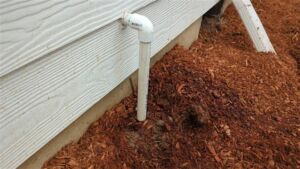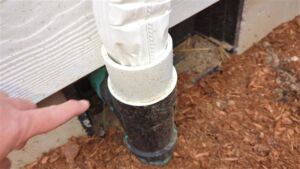
PVC (Polyvinyl Chloride) Schedule 40 pipe and fittings are typically not recommended for prolonged exposure to direct sunlight and outdoor conditions. While Schedule 40 PVC is commonly used for plumbing and other applications, it is not UV (ultraviolet) resistant, which means that extended exposure to sunlight can cause it to degrade and become brittle over time.

If you need to use PVC for an outdoor application, you should consider using Schedule 80 PVC or CPVC (Chlorinated Polyvinyl Chloride), which are more UV resistant than Schedule 40 PVC. Schedule 80 PVC or CPVC should still be painted or otherwise covered from exposure to UV radiation. Schedule 80 pipe is a much thicker and sturdier pipe that is more suited for exterior applications but is still comprised of the same materials that will, with time, degrade with sunlight exposure. Another option is to use PVC conduit with a suitable UV-resistant coating or covering. Always refer to the manufacturer’s specifications and recommendations for the specific product you plan to use, as different manufacturers may have variations in UV resistance and outdoor suitability.
Charlotte pipe is a leading manufacturer of plumbing and drainage systems in the United States. Below is an excerpt from the technical manual for the products they manufacture:
“ABS, CPVC, and PVC pipe can suffer surface discoloration when exposed to ultraviolet (UV) radiation from sunlight. UV radiation affects ABS, CPVC, and PVC when energy from the sun causes excitation of the molecular bonds in the plastic.
The presence of an opaque shield between the sun and the pipe prevents UV degradation. UV radiation will not penetrate thin shields such as paint coatings or wrappings. Burial of ABS, CPVC, and PVC pipe provides complete protection against UV attack. The most common method used to protect above ground ABS, CPVC, and PVC pipe from the sun is painting with a latex (water base) paint. Preparation of the surface to be painted is very important. The pipe should be cleaned to remove moisture, dirt, and oil and wiped with a clean, dry cloth. NOTICE: Petroleum-based paints should not be used, since the presence of petroleum will prevent proper bonding of paint to pipe.”
PVC, CPVC, and ABS can often be applied around the exterior of the home for many different tyes of applications. PVC is often used as a conduit for low voltage wiring at the irrigation system. ABS and PVC can often be used for underground storm drain system. These systems often have exposed components where storm drain risers connect with the adjacent downspout systems of the home. Lawn irrigation systems often use PVC piping for underground applications as well as above ground applications to connect to the home’s main water supply.
As mentioned previously, plastic plumbing is versatile, affordable, and durable and therefore is used in many applications, including many not mentioned here. Protecting these materials is easily achieved with the application of a layer of latex paint or other protective means that prevents contact from sunlight. Watch the video below to find out more about why it’s important to paint your PVC.
